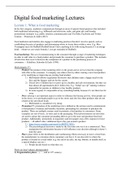Samenvatting
Digital Food Marketing Summary Lectures and Reading Material
- Instelling
- Tilburg University (UVT)
Summary of lecture notes, articles and the book 2022 -- Part of the Master Communication and Information Sciences at Tilburg University.
[Meer zien]




